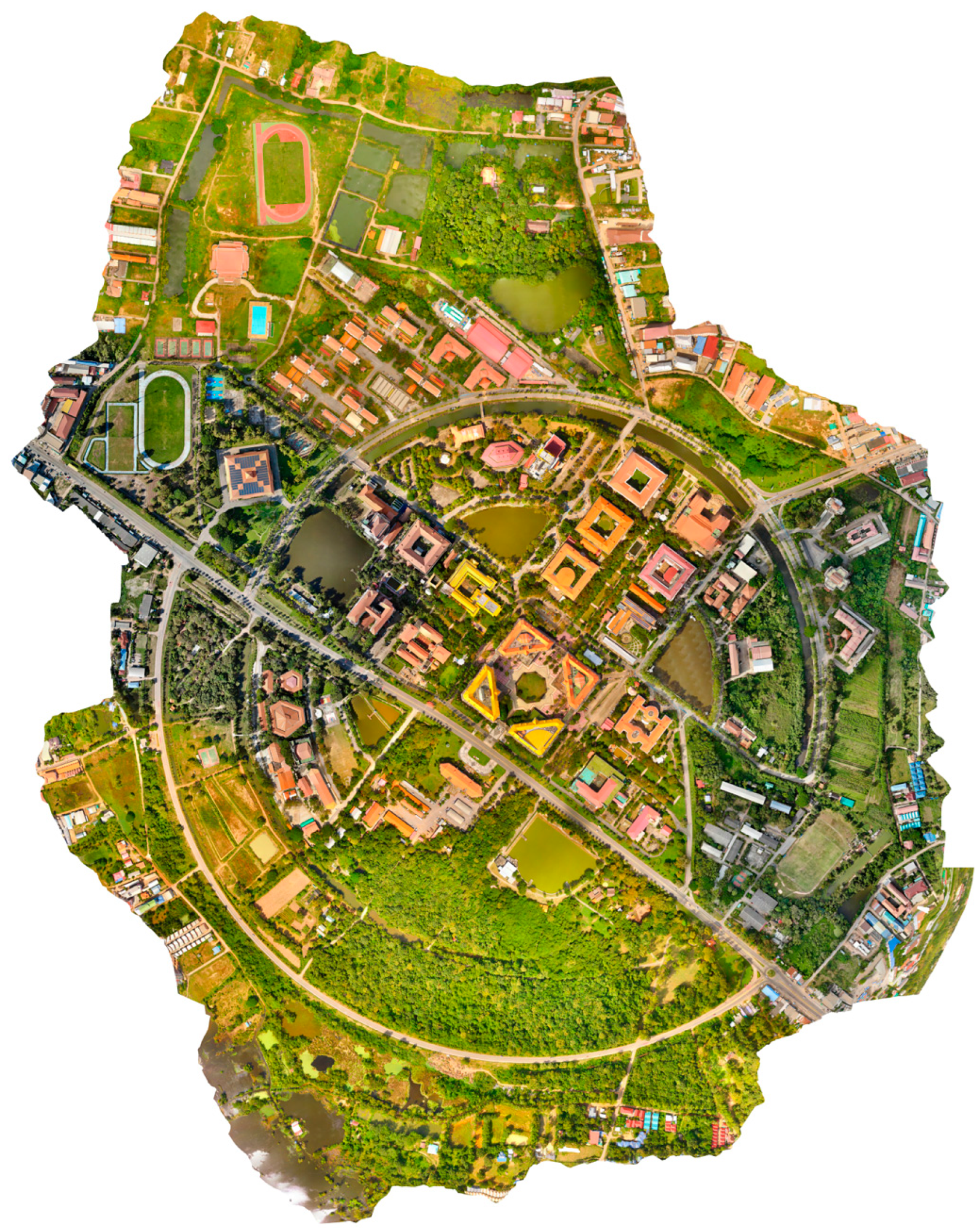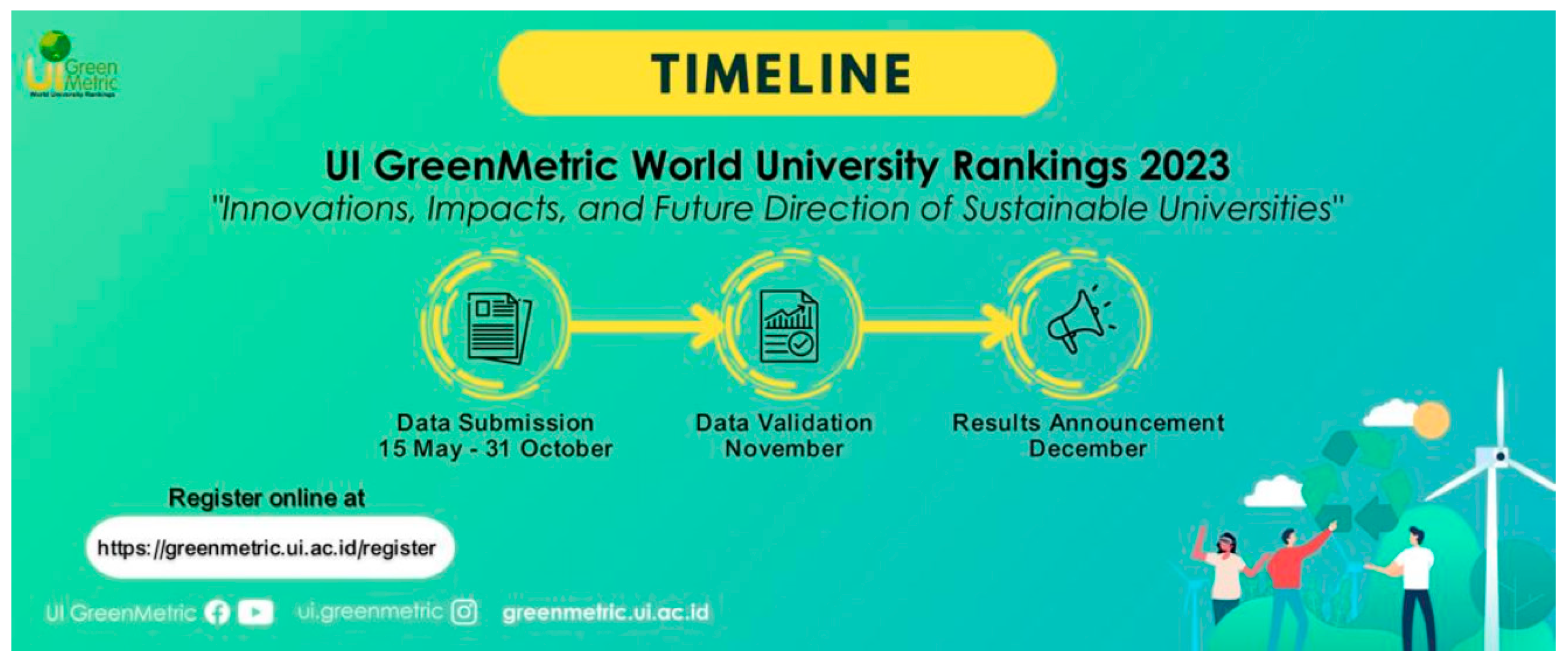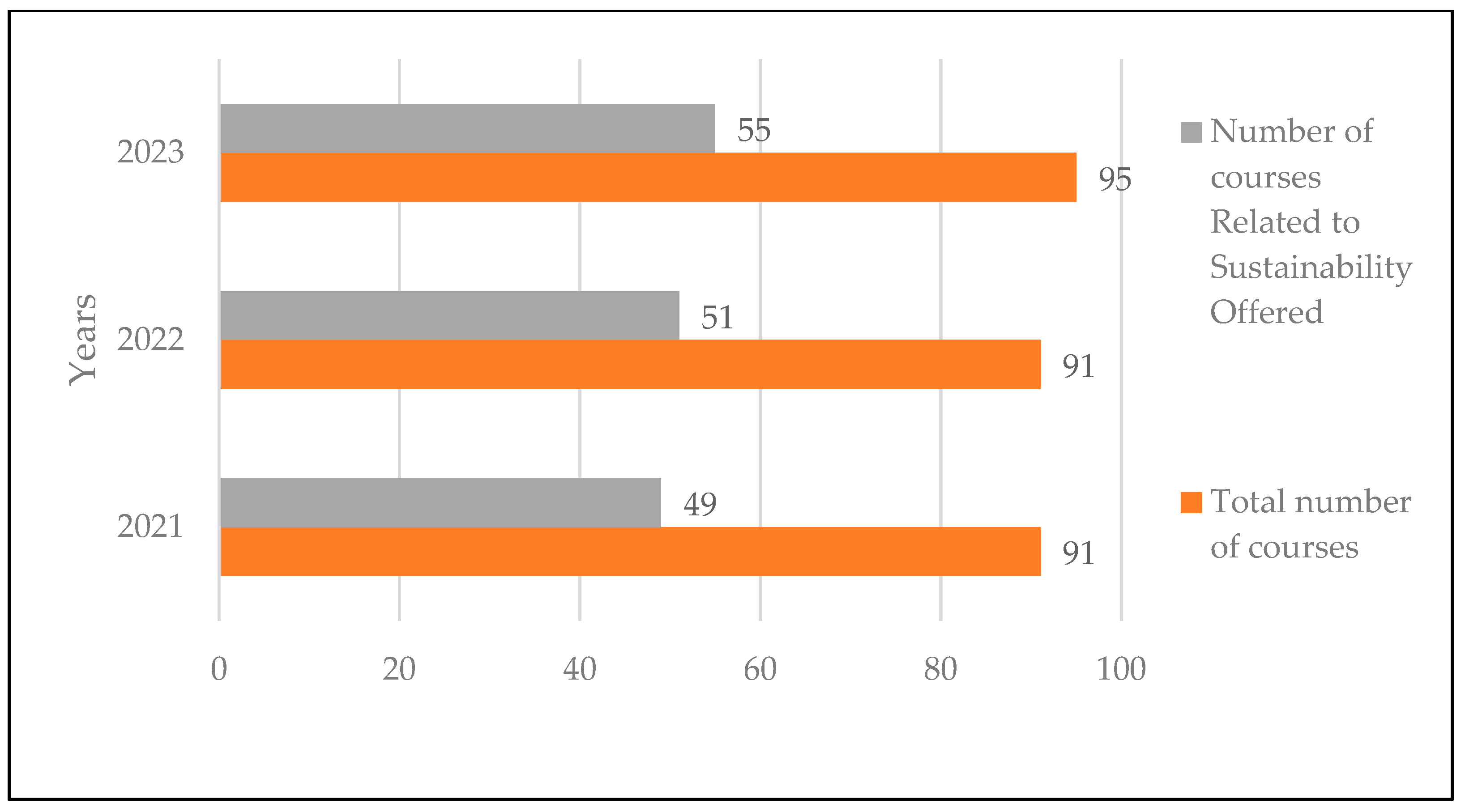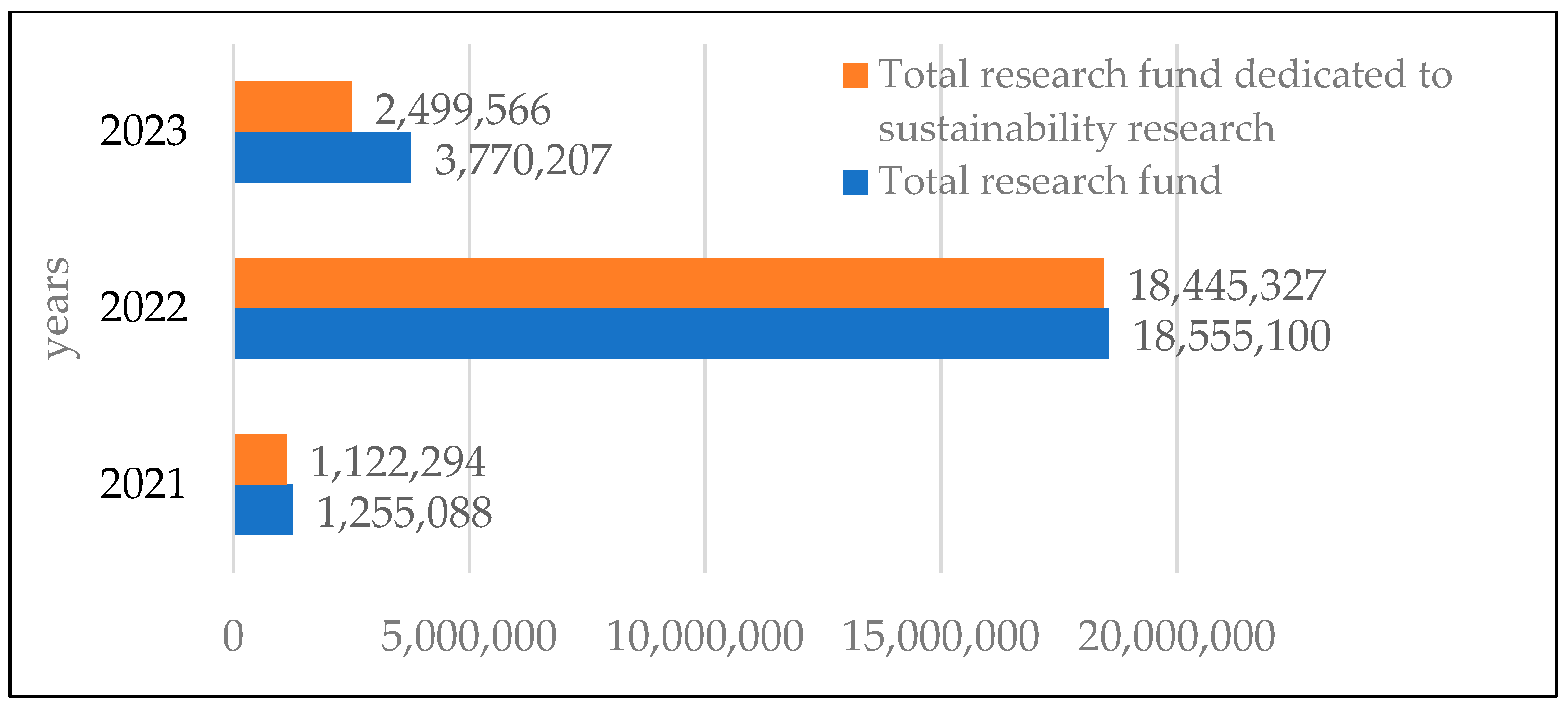The Sustainable Development Goals for Education and Research in the Ranking of Green Universities of Mahasarakham University
Abstract
1. Introduction
2. Materials and Methods
2.1. Research Area
2.2. Methodology
2.2.1. The Criteria
2.2.2. Scoring
2.3. Educational and Research Operations
2.3.1. Plan
2.3.2. Do
2.3.3. Check
2.3.4. Action
2.4. Data Preparation for Submission to the System
2.4.1. Data Preparation
2.4.2. Data Submission System Integration
3. Results and Discussion
- Total Number of Sustainable Curriculum Offerings
- 2.
- Research funding per Sustainable Research Fund
- 3.
- Number of sustainable publications
- 4.
- Number of sustainable community service projects organized and/or involving students
4. Conclusions
Author Contributions
Funding
Institutional Review Board Statement
Informed Consent Statement
Data Availability Statement
Conflicts of Interest
References
- Lauder, A.; Sari, R.F.; Suwartha, N.; Tjahjono, G. Critical review of a global campus sustainability ranking: GreenMetric. J. Clean. Prod. 2015, 108, 852–863. [Google Scholar] [CrossRef]
- Jiang, Q.; Kurnitski, J. Performance based core sustainability metrics for university campuses developing towards climate neutrality: A robust PICSOU framework. Sustain. Cities Soc. 2023, 97, 104723. [Google Scholar] [CrossRef]
- Boiocchi, R.; Ragazzi, M.; Torretta, V.; Rada, E. Critical Analysis of the GreenMetric World University Ranking System: The Issue of Comparability. Sustainability 2023, 15, 1343. [Google Scholar] [CrossRef]
- Atici, K.B.; Yasayacak, G.; Yilmaz, Y.; Ulucan, A. Green University and academic performance: An empirical study on UI GreenMetric and World University Rankings. J. Clean. Prod. 2021, 291, 125289. [Google Scholar] [CrossRef]
- Grigorescu, A.; Munteanu, I.; Dumitrica, C.-D.; Lincaru, C. Development of a Green Competency Matrix Based on Civil Servants’ Perception of Sustainable Development Expertise. Sustainability 2023, 15, 13913. [Google Scholar] [CrossRef]
- Perchinunno, P.; Cazzolle, M. A clustering approach for classifying universities in a world sustainability ranking. Environ. Impact Assess. Rev. 2020, 85, 106471. [Google Scholar] [CrossRef]
- Yong, J.Y.; Yusliza, M.Y.; Ramayah, T.; Farooq, K.; Tanveer, M.I. Accentuating the Interconnection between Green Intellectual Capital, Green Human Resource Management and Sustainability. Benchmarking 2023, 30, 2783–2808. [Google Scholar] [CrossRef]
- Sari, R.; Suwartha, N.; Setiani, H.; Sidiyanto, Y. The Impact of UI GreenMetric Involvement on Universities’ Performance in Shaping a Sustainable Campus. J. Sustain. Perspect. 2023, 3, 399–414. [Google Scholar] [CrossRef]
- Romero-Infante, J.; Ramírez, M.; Luna, L.; Leguizamón, S.; Verjel, E. Green Economy Metrics as a Promoter of Sustainable Development in Universities. Case Study: El Bosque University. J. Sustain. Perspect. 2022, 2, 439–448. [Google Scholar] [CrossRef]
- Ali, E.B.; Anufriev, V.P. Towards environmental sustainability in Russia: Evidence from green universities. Heliyon 2020, 8, e04719. [Google Scholar] [CrossRef]
- Abowardah, E.S.; Labib, W.; Aboelnagah, H.; Nurunnabi, M. Students’ Perception of Sustainable Development in Higher Education in Saudi Arabia. Sustainability 2024, 16, 1483. [Google Scholar] [CrossRef]
- Stibbe, D.; Prescott, D. The SDG Partnership Guidebook: A Practical Guide to Building High Impact Multi-Stakeholder Partnerships for the Sustainable Development Goals; The Partnering Initiative and UNDESA UN DESA and TPI, United Nation: New York, NY, USA, 2020. [Google Scholar]
- Javed, Y.; Alenezi, M. A Case Study on Sustainable Quality Assurance in Higher Education. Sustainability 2023, 15, 8136. [Google Scholar] [CrossRef]
- Harmon, R.R.; Moolenkamp, N. Sustainable it Services: Developing a Strategy Framework. Int. J. Innov. Technol. Manag. 2012, 9, 1250014. [Google Scholar] [CrossRef]
- Martínez-Acosta, M.; Vázquez-Villegas, P.; Mejía-Manzano, L.; Soto-Inzunza, G.; Ruiz-Aguilar, K.; Cuellar, L.; Caratozzolo, P.; Membrillo-Hernández, J. The Implementation of SDG12 in and from Higher Education Institutions: Universities as Laboratories for Generating Sustainable Cities. Front. Res. Sci. 2023, 5, 1158464. [Google Scholar] [CrossRef]
- Trinh, H.; McCord, M.; Lo, D.; Squires, G. Do Green Growth and Technological Innovation Matter to Infrastructure Investments in the Era of Climate Change? Global Evidence. Appl. Econ. 2022, 55, 4108–4129. [Google Scholar] [CrossRef]
- Mongkoldhumrongkul, K.; Sukkanta, P. Model of University Development in Thailand 4.0 Era toward “Green Campus Concept”. IOP Conf. Ser. Earth Environ. Sci. 2022, 1050, 012027. [Google Scholar] [CrossRef]
- Nuannukul, W.; Phumiphan, A.; Kangrang, A. Cross-Drainage Culvert Design under Global Climate and Land Use Changes. ARPN J. Eng. Appl. Sci. 2021, 16, 1036–1044. [Google Scholar]
- Lawanwadeekul, S.; Srisuwan, A.; Phonphuak, N.; Chindaprasirt, P. Enhancement of porosity and strength of clay brick fired at reduced temperature with the aid of corn cob and waste glass. Constr. Build. Mater. 2023, 369, 130547. [Google Scholar] [CrossRef]
- Phumiphan, A.; Kosasaeng, S.; Sivanpheng, O.; Hormwichian, R.; Kangrang, A. An Alternative Approach Using the Firefly Algorithm and a Hybrid Method Based on the Artificial Bee Colony and Cultural Algorithm for Reservoir Operation. Water 2024, 16, 816. [Google Scholar] [CrossRef]
- Phrophayak, J.; Techarungruengsakul, R.; Khotdee, M.; Thuangchon, S.; Ngamsert, R.; Prasanchum, H.; Sivanpheng, O.; Kangrang, A. Enhancing Green University Practices through Effective Waste Management Strategies. Sustainability 2024, 16, 3346. [Google Scholar] [CrossRef]
- Phonphuak, N.; Teerakun, M.; Srisuwan, A.; Ruenruangrit, P.; Saraphirom, P. The use of sawdust waste on physical properties and thermal conductivity of fired clay brick production. Int. J. Geomate 2020, 18, 24–29. [Google Scholar] [CrossRef]
- Phumiphan, A.; Kangrang, A. Development of Decision-Making Support Tools for Future Reservoir Management Under Climate and Land Cover Variability: A Case Study. Int. Rev. Civ. Eng. (IRECE) 2021, 12, 271–283. [Google Scholar] [CrossRef]
- Pajardo, E.; Kang, D. Sustainable Development Strategies on Campus: Reduce Water Consumption. World Environ. Water Resour. Congr. 2022, 2022, 130–140. [Google Scholar] [CrossRef]
- Ngamsert, R.; Techarungruengsakul, R.; Kaewplang, S.; Hormwichian, R.; Prasanchum, H.; Sivanpheng, O.; Kangrang, A. Optimizing Solution in Decision Supporting System for River Basin Management Consisting of a Reservoir System. Water 2023, 15, 2510. [Google Scholar] [CrossRef]
- Owojori, O.M.; Mulaudzi, R.; Edokpayi, J.N. Student’s Knowledge, Attitude, and Perception (KAP) to Solid Waste Management: A Survey towards a More Circular Economy from a Rural-Based Tertiary Institution in South Africa. Sustainability 2022, 14, 1310. [Google Scholar] [CrossRef]
- Anwar, N.; Mahmood, N.; Yusliza, M.; Ramayah, T.; Faezah, J.; Khalid, W. Green Human Resource Management for organi-sational citizenship behaviour towards the environment and environmental performance on a university campus. J. Clean. Prod. 2020, 256, 120401. [Google Scholar] [CrossRef]
- Dyer, G.; Dyer, M. Strategic leadership for sustainability by higher education: The American College & University Presidents’ Climate Commitment. J. Clean. Prod. 2017, 140, 111–116. [Google Scholar] [CrossRef]
- Phdungsilp, A. Waste Management and Its Contribution to the Sustainable Development Goals at Dhurakij Pundit University, Thailand. J. Sustain. Perspect. 2022, 2, 65–72. [Google Scholar] [CrossRef]
- Rakhmetullina, S.; Shaimardanov, Z.; Petrova, O.; Idrisheva, Z.; Kolpakova, V.; Apseitova, A. Green Metrics Questionnaire as the basis of Green University strategy. IOP Conf. Ser. Earth Environ. Sci. 2023, 1194, 012011. [Google Scholar] [CrossRef]
- Priyadarshini, P.; Abhilash, P. From piecemeal to holistic: Introducing sustainability science in Indian Universities to attain UN-Sustainable Development Goals. J. Clean. Prod. 2020, 247, 119133. [Google Scholar] [CrossRef]
- Thies, C. Multiple Identities and Scholarship in International Studies: 2019 ISA Presidential Address. Int. Stud. Q. 2020, 64, 259–265. [Google Scholar] [CrossRef]
- Kong, X.; Zhu, X.; Zhang, Y.; Wu, J. The application of plan, do, check, act (PDCA) quality management in reducing nosocomial infections in endoscopy rooms: It does work. Int. J. Clin. Pract. 2021, 75, e14351. [Google Scholar] [CrossRef] [PubMed]
- Sawalkar, R.; Undale, S.; Muluk, S.; Mude, G.; Saxena, V.; Pasumarti, S. Strategic waste management practices for environmental sustainability—A case of Indian university. Manag. Environ. Qual. 2023. [Google Scholar] [CrossRef]
- Shankar, Y.; Khandelwal, R. Sustainable waste management strategy for a campus: A case study of JUET, Guna. Manag. Environ. Qual. 2017, 28, 610–623. [Google Scholar] [CrossRef]
- GreenMetric—World University Rankings. (n.d.). Available online: https://greenmetric.ui.ac.id/ (accessed on 1 October 2023).
- Dabija, D.C.; Câmpian, V.; Tiron-Tudor, A.; Stanca, L. The path of universities to sustainability: Students perspectives during the COVID-19 pandemic. Heliyon 2023, 9, e14813. [Google Scholar] [CrossRef] [PubMed]
- Manso-Barrio, A.; Moya-Gómez, B.; Monzon, A.; Balsero, L. University Mobility Survey 2021 in Madrid Region (Spain): Facing the challenge of getting responses during the COVID-19 pandemic. Transp. Res. Procedia 2024, 76, 385–396. [Google Scholar] [CrossRef]
- Bedford, D.S.; Speklé, R.F.; Widener, S.K. Budgeting and employee stress in times of crisis: Evidence from the Covid-19 pandemic. Account. Organ. Soc. 2022, 101, 101346. [Google Scholar] [CrossRef]
- Baatwah, S.R.; Al-Qadasi, A.A.; Al-Shehri, A.M.; Derouiche, I. Corporate social responsibility budgeting and spending during COVID–19 in Oman: A humanitarian response to the pandemic. Financ. Res. Lett. 2022, 47, 102686. [Google Scholar] [CrossRef]







| No. | Categories | Percentage of Total Points (%) |
|---|---|---|
| 1 | Setting and Infrastructure (SI) | 15 |
| 2 | Energy and Climate Change (EC) | 21 |
| 3 | Waste (WS) | 18 |
| 4 | Water (WR) | 10 |
| 5 | Transportation (TR) | 18 |
| 6 | Education and Research (ED) | 18 |
| Total | 100 |
| No | Criteria | Points |
|---|---|---|
| ED1 | The ratio of sustainability courses to total courses/subjects | 300 |
| ED2 | The ratio of sustainability research funding to total research funding | 200 |
| ED3 | Number of scholarly publications on sustainability | 200 |
| ED4 | Number of events related to sustainability | 200 |
| ED5 | Number of student organizations related to sustainability | 200 |
| ED6 | University-run sustainability website | 200 |
| ED7 | Sustainability report | 100 |
| ED8 | Number of cultural activities on campus | 100 |
| ED9 | Number of university sustainability program(s) with international collaborations | 100 |
| ED10 | Number of sustainability community services project organized and/or involving students | 100 |
| ED11 | Number of sustainability-related startups | 100 |
| Total | 1800 | |
| Strategies | Indicators | Results/Year | Activity Budget for 2023 | ||
|---|---|---|---|---|---|
| 2021 | 2022 | 2023 | |||
| 1: Produce Graduates Meeting Global Demands | 1.1 Number of New Paradigm Courses or Sandbox Courses or International Collaboration Courses | - | - | 13 | 10 million THB |
| 1.2 Number of International Courses | 7 | 7 | 7 | ||
| 2: Foster Research and Innovation for International Excellence | 2.1 Amount of Funding from External Sources | 97.92 | 697 | 130 | 32 million THB |
| 2.2 Number of Research Projects Funded by Foreign Sources (million THB) | 17 | 12 | 34 | ||
| 2.3 Number of Research Outputs Published in International Databases (Scopus) | 513 | 659 | 668 | ||
| 2.4 Number of Innovations or Research Outputs Derived from Research | 21 | 20 | 41 | ||
| 2.5 Number of Internationally Collaborative Articles | 178 | 96 | 126 | ||
| 3: Provide Academic Services to Meet Industry and Community Needs | 3.1 Number of Research, Innovation, or Technology Projects Transferred to Industry/Society | 15 | 27 | 20 | |
| 3.2 Number of Communities and Societies Served with Academic Services Resulting in Strengthening and Self-reliance | 44 | 6 | 71 | 1.2 million THB | |
| 3.3 Number of Research, Innovation, or Technology Projects Transferred to Communities and Societies through Academic Services | 44 | 6 | 55 | ||
| 4: Enhance Isaan Cultural Excellence at the International Level | 4.1 Number of Internationally Outstanding Cultural Works Created | 5 | 7 | 11 | |
| 4.2 Number of Collaborative Cultural Work Activities in the Mekong River Basin and China | 4 | 6 | 7 | 1.6 million THB | |
| 4.3 Number of Cultural Works Adding Value/Significance | 5 | 7 | 10 | ||
| 5: Manage the Organization for University Excellence | 5.1 Number of Digital Technology Innovations | - | 1 | 1 | 3.2 million THB |
| 5.2 UI Green Metric Assessment Scores | 7575 | 8200 | 8335 | ||
| Number of Publications | 2021 | 2022 | 2023 |
|---|---|---|---|
| Publication related to “Green and Sustainability” | 262 | 309 | 298 |
| Publication related to “Environment” | 1160 | 1190 | 1220 |
| Publication related to “Renewable Energy” | 775 | 847 | 801 |
| Publication related to “Climate Change” | 923 | 1050 | 958 |
| Total number of publications | 3120 | 3396 | 3277 |
| Projects | 2021 | 2022 | 2023 |
|---|---|---|---|
| Sustainable Community Service Projects | 44 | 6 | 71 |
Disclaimer/Publisher’s Note: The statements, opinions and data contained in all publications are solely those of the individual author(s) and contributor(s) and not of MDPI and/or the editor(s). MDPI and/or the editor(s) disclaim responsibility for any injury to people or property resulting from any ideas, methods, instructions or products referred to in the content. |
© 2024 by the authors. Licensee MDPI, Basel, Switzerland. This article is an open access article distributed under the terms and conditions of the Creative Commons Attribution (CC BY) license (https://creativecommons.org/licenses/by/4.0/).
Share and Cite
Sribanasarn, W.; Techarungruengsakul, R.; Khotdee, M.; Thuangchon, S.; Ngamsert, R.; Phumiphan, A.; Sivanpheng, O.; Kangrang, A. The Sustainable Development Goals for Education and Research in the Ranking of Green Universities of Mahasarakham University. Sustainability 2024, 16, 3618. https://doi.org/10.3390/su16093618
Sribanasarn W, Techarungruengsakul R, Khotdee M, Thuangchon S, Ngamsert R, Phumiphan A, Sivanpheng O, Kangrang A. The Sustainable Development Goals for Education and Research in the Ranking of Green Universities of Mahasarakham University. Sustainability. 2024; 16(9):3618. https://doi.org/10.3390/su16093618
Chicago/Turabian StyleSribanasarn, Woraluck, Rapeepat Techarungruengsakul, Mathinee Khotdee, Sattawat Thuangchon, Ratsuda Ngamsert, Anujit Phumiphan, Ounla Sivanpheng, and Anongrit Kangrang. 2024. "The Sustainable Development Goals for Education and Research in the Ranking of Green Universities of Mahasarakham University" Sustainability 16, no. 9: 3618. https://doi.org/10.3390/su16093618
APA StyleSribanasarn, W., Techarungruengsakul, R., Khotdee, M., Thuangchon, S., Ngamsert, R., Phumiphan, A., Sivanpheng, O., & Kangrang, A. (2024). The Sustainable Development Goals for Education and Research in the Ranking of Green Universities of Mahasarakham University. Sustainability, 16(9), 3618. https://doi.org/10.3390/su16093618







